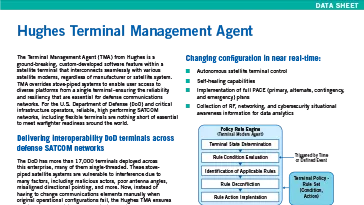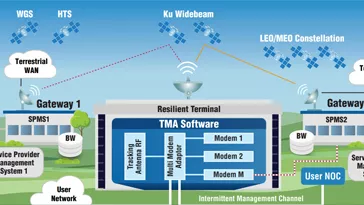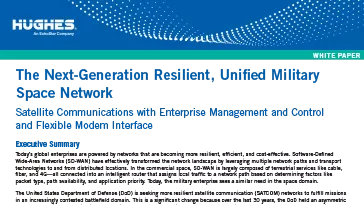Resilient Networking
Powered by Intelligent Software Technology from Hughes
For the U.S. Department of Defense (DoD) and critical infrastructure operators, reliable, high-performing SATCOM networks are nothing short of essential to meet warfighter and infrastructure continuity demands around the world. They need resilient networks that automatically and rapidly orchestrate maximum diversity, redundancy, and security options—which is why Hughes developed the Terminal Management Agent (TMA).
Based on flexible modem and terminal interface standards (FMI and TMI), TMA is the key to unlocking true network resilience. Built with Artificial Intelligence (AI) rules-engine technology, TMA modernizes existing terminals to support rapid deployment of operational policies and the ultimate in SATCOM network flexibility.
Hughes Terminal Management Agent
The TMA from Hughes is a ground-breaking, custom-developed software feature within a satellite terminal that interconnects seamlessly with various satellite modems, regardless of manufacturer or satellite system. TMA overrides stove-piped systems to enable user access to diverse platforms from a single terminal – ensuring the reliability and resiliency that are essential for defense communications networks.
Single-threaded satellite systems are vulnerable to interference due to many factors, including malicious actors, poor antenna angles, misaligned directional pointing, and more. Now, instead of having to change communications elements manually when original operational configurations fail, the Hughes TMA ensures continuous connectivity to meet mission requirements. With TMA in use on a satellite terminal, if a degraded or disrupted transmission occurs for any reason, automated terminal management and control will use alternate networks to “self-heal” connections.
The result is network resilience – yielding faster connectivity, greater reliability, and enhanced interoperability across military and commercial SATCOM networks.
Advantages of Hughes TMA
The TMA software from Hughes powers autonomous satellite terminal control across diverse modems, services, satellites and service providers. The software uses situational data – including the operational environment, mission plans, potential satellite access issues, and mission priority based on available services – to make autonomous decisions about its host terminal’s use of diverse resources.
Incorporating the standards for flexible modem and terminal interfaces (FMI and FTI), which Hughes helped develop, TMA ensures continuous connectivity across:
- Orbits - GEO, MEO and LEO satellites
- Bands - Ku-, Ka-, Mil Ka-, X- and C-band transmissions
- Manufacturers – Hughes, Comtech, iDirect, etc. using various waveforms
- Service providers – Commercial and defense providers
Able to change its configuration in near real-time using Artificial Intelligence (AI) rules-engine technology, TMA delivers:
- Autonomous satellite terminal control
- Self-healing capabilities
- Implementation of full PACE (primary, alternate, contingency, and emergency) plans
- Collection of RF, networking, and cybersecurity situational awareness information for data analytics
Responding to the Needs for Resilient Networks
Since 2017, Hughes has been working with DoD to develop the ultimate SATCOM flexibility. Now available for wider use, TMA can be incorporated into any terrestrial or aeronautical SATCOM solution for the DoD and critical infrastructure.
-
2017
DoD tapped Hughes for a study to help assess the ideal hybrid SATCOM architecture and how diverse systems can work together. In the first phase of the study, Hughes recommended a SATCOM strategy that supports interoperability for wideband applications to enhance communications infrastructure and reduce acquisition and operations costs.
-
2018
In a second phase, Hughes built on recommendations from the first study to explore how an interoperable system solution can be implemented effectively. As part of this phase, Hughes produced a new TMA software implementing Flexible Modem Interface (FMI) standard for demonstration and evaluation.
Hughes demonstrated the TMA/FMI technology to the DoD using a ground terminal with an auto-tracking antenna, spanning three satellites, three modems, and two service providers.
-
2019
Hughes and NASA together tested the TMA/FMI technology in a demonstration with the International Space Station (ISS), autonomously switching a communications signal, from the FMI-outfitted, ground terminal, between different modems aboard the ISS.
-
2020
Hughes demonstrated the TMA/FMI and Enterprise Management and Control (EMC) technologies with full PACE planning and Situational Awareness using a Hughes software-defined HM400 modem and a GetSat Ku-band aero antenna with a video sensor and a Comtech DMD-2050E.
Related Resources

Integrating advanced commercial technologies and embracing agile development methodologies

A vision for next generation, integrated and interoperable base communication systems.

Features and benefits of this custom-developed software feature from Hughes.

TMA software is the key to unlocking truly resilient networking for terminal modernization.

DoD seeks more resilient and uninterrupted SATCOM to fulfill missions.


TMA delivers the ultimate in SATCOM flexibility to ensure resilient networking across land, aero and maritime comms.

